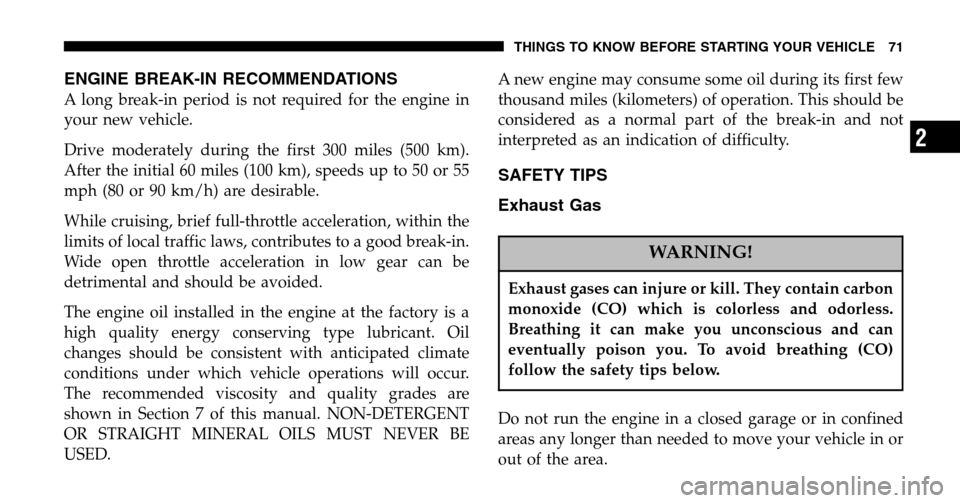Page 71 of 440

ENGINE BREAK-IN RECOMMENDATIONS
A long break-in period is not required for the engine in
your new vehicle.
Drive moderately during the first 300 miles (500 km).
After the initial 60 miles (100 km), speeds up to 50 or 55
mph (80 or 90 km/h) are desirable.
While cruising, brief full-throttle acceleration, within the
limits of local traffic laws, contributes to a good break-in.
Wide open throttle acceleration in low gear can be
detrimental and should be avoided.
The engine oil installed in the engine at the factory is a
high quality energy conserving type lubricant. Oil
changes should be consistent with anticipated climate
conditions under which vehicle operations will occur.
The recommended viscosity and quality grades are
shown in Section 7 of this manual. NON-DETERGENT
OR STRAIGHT MINERAL OILS MUST NEVER BE
USED. A new engine may consume some oil during its first few
thousand miles (kilometers) of operation. This should be
considered as a normal part of the break-in and not
interpreted as an indication of difficulty.
SAFETY TIPS
Exhaust Gas
WARNING!
Exhaust gases can injure or kill. They contain carbon
monoxide (CO) which is colorless and odorless.
Breathing it can make you unconscious and can
eventually poison you. To avoid breathing (CO)
follow the safety tips below.
Do not run the engine in a closed garage or in confined
areas any longer than needed to move your vehicle in or
out of the area.
THINGS TO KNOW BEFORE STARTING YOUR VEHICLE 71
2
Page 346 of 440

NOTE:IfANY of these apply to you then change your
engine oil every 3,000 miles (5 000 km) or 3 months,
whichever comes first and follow schedule “B” of the
� Maintenance Schedules �section of this manual.
If none of these apply to you, then change your engine oil
at every interval shown on schedule �A�of the �Mainte-
nance Schedules �section of this manual.
NOTE: Under no circumstances should oil change in-
tervals exceed 6000 miles (10 000 km) or 6 months
whichever comes first.
Engine Oil Selection
For best performance and maximum protection under all
types of operating conditions, the manufacturer only
recommends engine oils that are API certified and meet
the requirements of DaimlerChrysler Material Standard
MS-6395.
American Petroleum Institute (API) Engine Oil
Identification Symbol
This symbol means that the oil has
been certified by the American
Petroleum Institute (API). The
manufacturer only recommends
API Certified engine oils.
Engine Oil Viscosity (SAE Grade) — 3.5 Liter
Engines
The proper SAE viscosity grade of engine oil should be
selected based on the following recommendation and be
within the operating temperature shown in the engine oil
viscosity chart.
346 MAINTAINING YOUR VEHICLE
Page 347 of 440
•SAE 10W-30engine oil is preferred. SAE 5W-30 engine
oil is allowed during cold weather only to improve
cold weather starting.
Lubricants which do not have both, the engine oil certi-
fication mark and the correct SAE viscosity grade num-
ber should not be used.
Engine Oil Viscosity (SAE Grade) — 3.8 Liter
Engines
SAE 5W-20 engine oil is recommended for all operating
temperatures. This engine oil improves low temperature
starting and vehicle fuel economy. Your engine oil filler
cap also shows the recommended engine oil viscosity for
your vehicle.
For information on engine oil filler cap location, refer to
the Engine Compartment illustration in this section.
Lubricants which do not have both, the engine oil certi-
fication mark and the correct SAE viscosity grade num-
ber should not be used.
MAINTAINING YOUR VEHICLE 347
7
Page 348 of 440

Synthetic Engine Oils
There are a number of engine oils being promoted as
either synthetic or semi-synthetic. If you chose to use
such a product, use onlythose oils that are American
Petroleum Institute (API) Certified and have the recom-
mended SAE viscosity grade. Follow the maintenance
schedule that describes your driving type.
Materials Added to Engine Oil
The manufacture strongly recommends against the addi-
tion of any additives (other than leak detection dyes) to
the engine oil. Engine oil is an engineered product and
it’s performance may be impaired by supplemental ad-
ditives.
Disposing of Used Engine Oil And Oil Filters
Care should be taken in disposing of used engine oil and
oil filters from your vehicle. Used oil and oil filters,
indiscriminately discarded, can present a problem to the
environment. Contact your dealer, service station, or governmental agency for advice on how and where used
oil and oil filters can be safely discarded in your area.
Engine Oil Filter
The engine oil filter should be replaced at every engine
oil change.
Engine Oil Filter Selection
This manufacture’s engines have a full-flow type oil filter.
Use a filter of this type for replacement. The quality of
replacement filters varies considerably. Only high quality
filters should be used to assure most efficient service.
Mopar Engine Oil Filters are a high quality oil filter and
are recommended.
Drive Belts — Check Condition and Tension
At the mileage indicated in the maintenance schedule, all
belts should be checked for condition and proper tension.
Improper belt tension can cause belt slippage and failure.
348 MAINTAINING YOUR VEHICLE
Page 387 of 440
FLUIDS, LUBRICANTS AND GENUINE PARTS
Engine
Component Fluids, Lubricants and Genuine Parts
Engine Coolant Mopar �Antifreeze/Coolant 5 Year/100,000 Mile Formula HOAT (Hybrid Or-
ganic Additive Technology) or equivalent
3.5 Liter Engine Oil Use API Certified SAE 10W-30 engine oil, refer to oil viscosity chart for cor- rect SAE grade meeting DaimlerChrysler Material Standard MS-6395.
3.8 Liter Engine Oil Use API Certified SAE 5W-20 engine oil. Refer to your oil filler cap for cor- rect SAE grade, meeting DaimlerChrysler Material Standard MS-6395.
Spark Plugs Refer to the Vehicle Emission Control Information label in the engine com- partment.
Oil Filter, 3.5/3.8 Liter Engines Mopar � 5281090 or equiv.
Fuel Selection 89 Octane
MAINTAINING YOUR VEHICLE 387
7
Page 432 of 440

Occupant Restraints....................... 33
Octane Rating, Gasoline (Fuel) .............. 296
Odometer ............................. 172
Oil, Engine ......................... 344,387
Capacity ............................ 386
Change Interval ....................... 345
Checking ............................ 344
Disposal ............................ 348
Filter ............................ 348,387
Filter Disposal ........................ 348
Identification Logo ..................... 346
Materials Added to ..................... 348
Recommendation ................... 346,386
Synthetic ............................ 348
Viscosity ....................... 346,347,386
Onboard Diagnostic System ..............340,341
Opener, Garage Door (HomeLink �) ........... 142
Operator Manual (Owner’s Manual) ............ 4
Overdrive ............................. 264 Overhead Console
....................... 141
Overhead Travel Information Center .......... 141
Overheating, Engine ................... 168,319
Owner’s Manual (Operator Manual) .........4,418
Panic Alarm ............................ 22
Parking Brake .......................... 266
Parking On Hill ......................... 267
Passing Light ........................... 130
Pedals, Adjustable ....................... 137
Pets, Transporting ........................ 70
Phone, Cellular .......................... 83
Phone, Hands-Free (UConnect™) ............. 83
Placard, Tire and Loading Information ......... 278
Power Brakes .............................. 268
Distribution Center ..................... 377
Door Locks ........................... 17
Lift Gate ............................. 29
432 INDEX